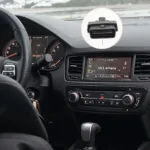Manually clearing OBD2 codes is a common practice among car owners. This guide provides a step-by-step approach to understanding and executing the process effectively and safely. We’ll cover everything from locating your OBD2 port to interpreting the codes and addressing the underlying issues.
Understanding OBD2 Codes and Why You Might Want to Clear Them
OBD2 (On-Board Diagnostics II) is a standardized system that allows you to access your vehicle’s diagnostic information. When something goes wrong, the system generates a diagnostic trouble code (DTC), commonly referred to as an OBD2 code. These codes can indicate a wide range of problems, from minor sensor malfunctions to serious engine issues. Clearing these codes can be useful for several reasons: verifying a repair, resetting the check engine light, or simply starting fresh with your diagnostics. craftman 1655 obd2 code reader can help you understand these codes.
Locating Your OBD2 Port
The first step in manually clearing OBD2 codes is locating the OBD2 port. In most vehicles, it’s located under the dashboard on the driver’s side, within reach of the steering wheel. Sometimes, it’s hidden behind a panel or located in the center console or glove compartment. Refer to your vehicle’s owner’s manual for the exact location.
Methods for Manually Clearing OBD2 Codes
There are several ways to manually clear OBD2 codes.
-
Disconnecting the Battery: This is the most basic method. Disconnect the negative terminal of your car battery for about 30 minutes. This resets the vehicle’s computer, clearing stored codes and other data.
-
Using a Jumper Wire: This method involves shorting specific pins on the OBD2 port. However, this method is not recommended for most users, as it can potentially damage the vehicle’s electrical system if done incorrectly.
-
Using an OBD2 Scanner: This is the most reliable and recommended method. An mt-07 obd2 scanner allows you to read and clear codes easily and safely. Many affordable scanners are available on the market.
Step-by-Step Guide to Clearing Codes with an OBD2 Scanner
-
Locate your vehicle’s OBD2 port. It is usually under the dashboard on the driver’s side. If you’re unsure, where do i plug in a obd2 auto scanner provides helpful information.
-
Plug the OBD2 scanner into the port.
-
Turn the ignition key to the “on” position, but don’t start the engine.
-
Turn on the OBD2 scanner.
-
Select the “read codes” option.
-
Once the codes are displayed, select the “clear codes” or “erase codes” option.
-
Confirm the action when prompted.
Importance of Addressing the Underlying Issue
While clearing codes can temporarily turn off the check engine light, it’s essential to remember that this doesn’t fix the underlying problem. If you don’t address the root cause, the codes will likely return. A 2018 dodge obd2 port adaptor might be helpful for specific vehicle models.
What if the Code Returns After Clearing?
If the code reappears after clearing it, this indicates a persistent problem that needs further investigation. It’s crucial to have a qualified mechanic diagnose and repair the issue.
“Ignoring a recurring OBD2 code is like ignoring a flashing warning light on your dashboard,” says automotive expert, Michael Stevens. “It’s essential to address the underlying problem to prevent further damage and ensure the safety and reliability of your vehicle.”
Conclusion
Manually clearing OBD2 codes can be a useful tool for car maintenance, but it’s important to remember it’s not a permanent fix. Understanding the process and addressing the underlying issue are crucial for keeping your car running smoothly. Ignoring the root cause can lead to more serious problems down the road. An obd2 civic 2000 example illustrates how these codes can vary by model.
FAQ
- How often should I clear my OBD2 codes? Only when necessary, after a repair, or for diagnostic purposes.
- Will clearing the codes void my warranty? No.
- Can I clear codes without a scanner? Yes, by disconnecting the battery, but it’s not the recommended method.
- Is it safe to drive with the check engine light on? It depends on the code. Some codes indicate minor issues, while others suggest serious problems that require immediate attention.
- How can I find a reliable mechanic? Seek recommendations from friends, family, or online reviews.
- What are some common OBD2 codes? P0420 (Catalyst System Efficiency Below Threshold), P0171 (System Too Lean), P0300 (Random/Multiple Cylinder Misfire).
- How can I learn more about specific OBD2 codes? Research online or consult a repair manual.
Do you have other questions regarding your vehicle’s diagnostic system or need more information on OBD2 scanners? Check out our other helpful articles on OBDFree.com.
For immediate assistance, contact us via WhatsApp: +1(641)206-8880, Email: [email protected] or visit us at 789 Elm Street, San Francisco, CA 94102, USA. We offer 24/7 customer support.
